Exploring…
I’m busy with my eighth novel for Bookouture. I reached a point where I needed objectivity. It was time to put the manuscript away for a few days.
So, we went on a trip and I completely switched off from my writing (or at least as much as a writer ever does).
We don’t enjoy over-touristy places and had never visited Southern Tuscany/Northern Lazio. In a book I recently read (Notes from an Italian Garden by Joan Marble – highly recommended if you are both an Italophile and a keen gardener), I had read of an area where the author had bought a house in the 1960s. This is when I lived near Rome as a child, so I was intrigued. The decision to buy there was based on wanting to live in a lesser-known area and her opening chapters spoke to me. She talked about enjoying the “obscurity” of southern Etruria, as opposed to cities like Florence and Venice where inhabitants struggle to get around because of the hordes of tourists.
“Like the princess who guessed that her frog was really a handsome prince, we know that our corner of Etruria is really a jewel of rare beauty, and has a mystic quality tied to its ancient Etruscan roots.”

We didn’t travel by Ape – but we found this parked in Sorano: the owner had hacked out a bit of wall next to his house to accommodate his vehicle in a narrow alleyway!
The author had me with her descriptions. We went to explore and we were not disappointed. Our first two days were spent between northern Lazio and southern Tuscany. Firstly, we dropped into (a rather touristy, admittedly) town perched impossibly on tufa rock. Civita Bagnoregio was a spectacle in itself, located in the eroded badlands and approached by a walkway. It was a good start.
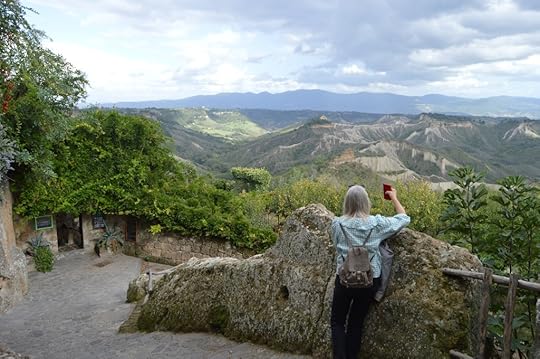
The intriguing badlands around Civita Bagnoregio

The town, known as the dying city, is approached by a 5 euro toll walkway since landslides continue to erode the terrain
Next, we visited the amazing museum in Tarquinia to try and acquaint ourselves with the Etruscans who created such wonderful artefacts over more than 2,500 years ago. There has been prolific theft from tombs over the past centuries. Thankfully not everything has been plundered.
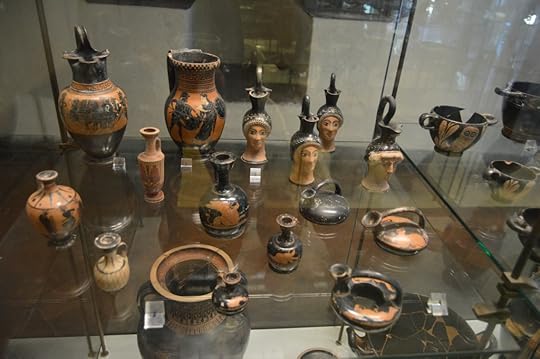
Studies show that Etruscans were an indigenous people, their culture first identified from around 900 BC and centred round the regions of Lazio, Tuscany and Umbria. Their alphabet is known, but not their language, which leaves much mystery, speculation and academic theory. We were intrigued with the amazing tombs depicting the Etruscan attitude to life beyond the tomb: the Aldilà (and ergo, to my way of thinking, life). Banquet scenes, hunting, feasting and sexual activity filled the walls, the scenes still vivid after thousands of years.
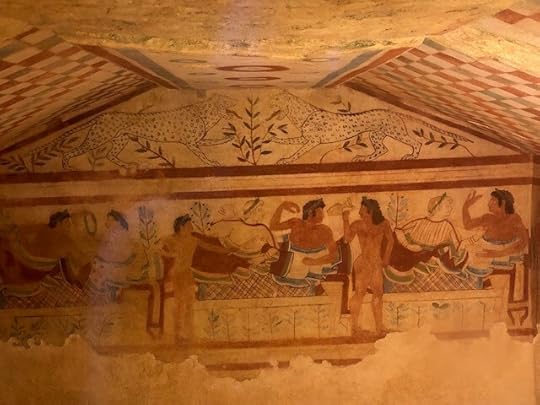
Other towns perched on tufa rock, especially Pitigliano and Sorano (where we stayed in an incredible fortress, La Fortezza which we highly recommend) were the highlights of the second half of our little break.
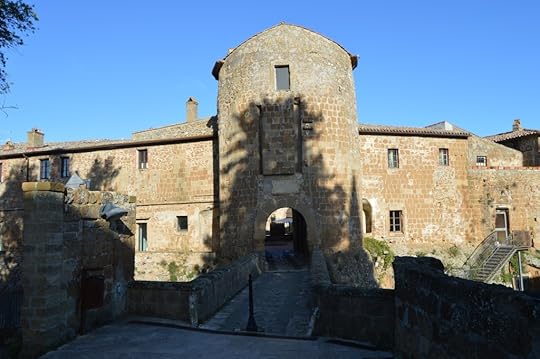
Grand entrance to our splendid and very reasonably priced hotel for two nights: La Fortezza, Sorano
The owners arranged a fantastic night walk with a knowledgeable guide, Lorenzo.
Do look him up of you are in the area. His explanations of le vie cave up to the church of San Rocco (the hollowed paths), hacked out by Etruscans to likely take their dead up to the mountainside for burial, as well as many other details he pointed out we would have otherwise missed, was altogether an unforgettable experience. The night view, like a Christmas scene, of the town of Sorano, capped it. On the following day we returned alone by day, remembering his information. We came across more tombs/dwellings in the rocks below the viewing point. Truly spectacular!

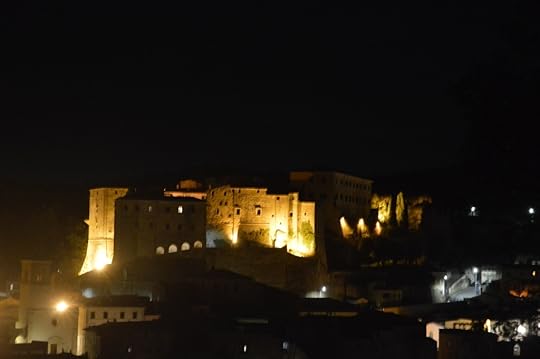
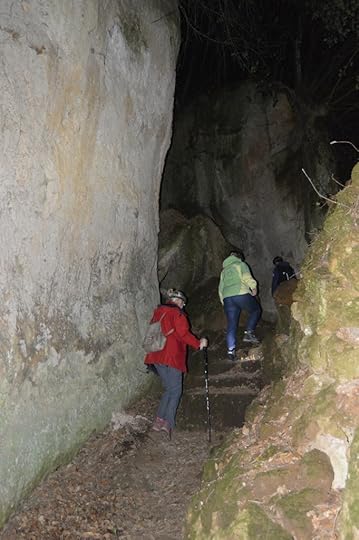
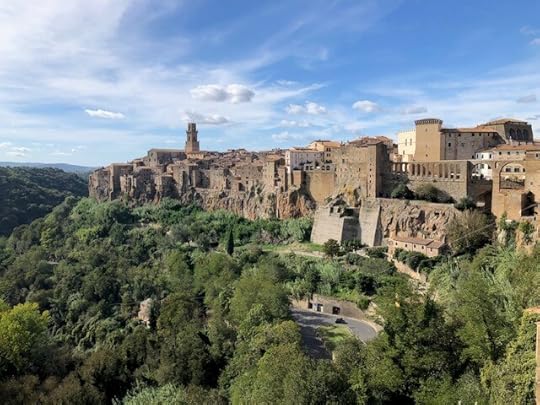
Pitigliano
Other not-to-be-missed visits included a walk around Viterbo (we want to return for longer) and awe-inspiring stops at the beautiful, eleventh century cathedrals of Sovana and Tuscania, with origins dating back to the ninth century: (Santa Maria Maggiore and San Pietro). The Etruscan and Roman ruins of Vulci made me feel that not much progress has been made over the last millennia. Plumbing, spas and dance floors were included in this ancient villa and ingenious ways of collecting rainwater in a territory that remains parched for many months of the year.
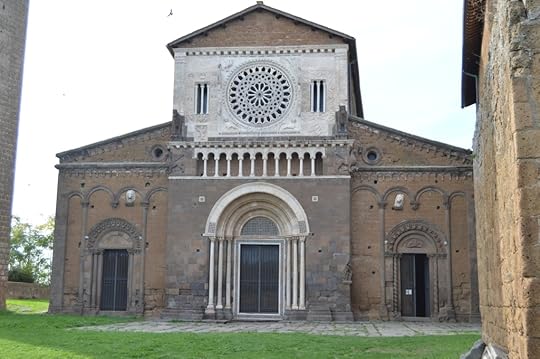
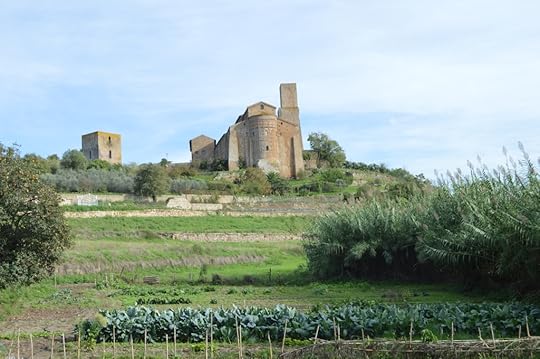
It was an exhilarating, exciting, tiring but very necessary break. I have returned with new ideas and energy. It’s important to remain flexible with goals and my present novel is slightly different from my usual but I shall continue to be bold.
Something had been niggling me about the last part of my novel (call it Act III). I was building up an obstacle that I felt I had to conquer. A sensible part of my brain that I didn’t want to listen to before is now telling me to quit, to release that idea; that it is unnecessary and pulling the story into a shape that won’t squeeze into the structure. Rather like trying to squeeze excess toothpaste into a small tube. Quit or persist? I don’t like giving up but I now understand what I have to do. A change is as good as a rest but a change also serves to gain perspective, so I’m grateful for our mini-break. (And I’m in awe of the Etruscans).
Onwards! A door has opened.




